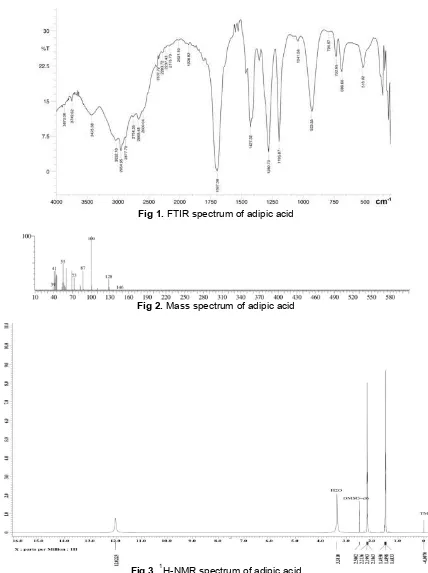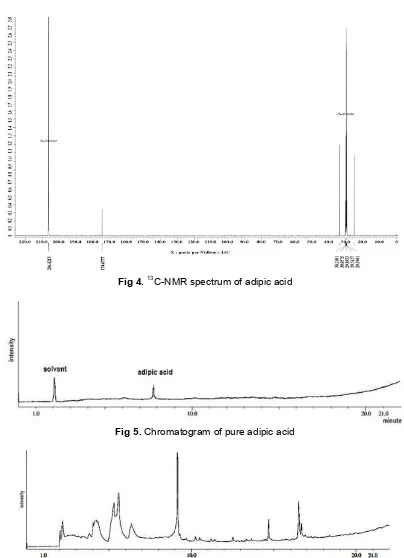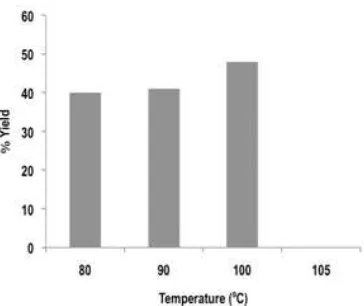CONVERSION OF CYCLOHEXANONE TO ADIPIC ACID
CATALYZED BY HETEROPOLY COMPOUNDS
Aldes Lesbani
*, Fitriliana, and Risfidian Mohadi
Department of Chemistry, Faculty of Mathematics and Natural Sciences, Sriwijaya University, Jl. Raya Palembang Prabumulih Km32, Ogan Ilir Sumatera Selatan 30662, Indonesia
Received July 22, 2014; Accepted November 5, 2014
ABSTRACT
Conversion of cyclohexanone to adipic acid using hydrogen peroxide as green oxidant catalyzed by heteropoly compounds i.e. H5[-BW12O40] H4[-SiW12O40] and H4[-PVMo11O40] has been carried out systematically in one pot
synthesis under mild condition. The product of adipic acid was characterized using GC-MS, FT-IR,1H-NMR and13 C-NMR spectroscopy. The results show that cyclohexanone could be converted into adipic acid by using H5[
-BW12O40] H4[-SiW12O40] as catalysts, whereas H4[-PVMo11O40] did not shows catalytic activity in this reaction. The
effect of reaction time gave adipic acid 41% for reaction time 7 h. The yield of adipic acid was 30% with melting point 149-151 °C. The oxidation temperature at 100 °C gave the highest adipic acid 48% was obtained. The FT-IR,
1
H-NMR and13C-NMR spectra of the product are well agreed to the adipic acid standard.
Keywords:cyclohexanone; adipic acid; heteropoly compounds
ABSTRAK
Konversi sikloheksanon menjadi asam adipat menggunakan hidrogen peroksida sebagai pengoksidasi ramah lingkungan yang dikatalis senyawa heteropoli yakni H5[-BW12O40] H4[-SiW12O40] and H4[-PVMo11O40] telah
dilakukan melalui reaksi satu langkah dengan kondisi ringan. Produk asam adipat dikarakterisasi melalui penentuan titik leleh, pengukuran menggunakan GC-MS, FT-IR,1H-NMR dan13C-NMR. Hasil penelitian menunjukkan bahwa sikloheksanon dapat dikonversi menjadi asam adipat hanya dengan menggunakan katalis H5[-BW12O40]
H4[-SiW12O40], sedangkan H4[-PVMo11O40] tidak menunjukkan aktivitas katalitik pada reaksi ini. Studi pengaruh
waktu reaksi menunjukkan bahwa diperoleh asam adipat sebanyak 41% untuk reaksi 7 jam. Rendemen asam adipat yakni 30% dengan titik leleh 149-151 °C. Studi pengaruh temperatur oksidasi menunjukkan bahwa rendemen asam adipat tertinggi diperoleh sebanyak 48% pada temperatur 100 °C. Spektra FT-IR, 1H-NMR dan 13C-NMR asam adipat sesuai dengan spektra asam adipat standar.
Kata Kunci:sikloheksanon; asam adipat; senyawa heteropoli
INTRODUCTION
Adipic acid is an important and valuable chemical to produce nylon-6,6, plastics, fibers, and food additives. The worldwide production of adipic acid mainly for raw material of nylon-6,6 is up to 2.2 million metric tons per year [1]. The industrial and conventional production of adipic acid used nitric acid as oxidation agent in the oxidation of cyclohexanone, cyclohexanol, and mixture of cyclohexanone-cyclohexanol [2]. The use of conventional catalyst such as nitric acid leads to produce N2O and NOx as by products, which are pollutants and
not environmentally benign do to contribute significantly to global warming. Thus the use of green oxidant such as hydrogen peroxide to produce of adipic acid is vital.
Aqueous hydrogen peroxide is an ideal, green and clean oxidant for oxidation reaction [3]. Sato et al. (1998)
was reported the aqueous hydrogen peroxide with concentration low than 60% can be used as clean oxidant in the oxidation reaction including production of adipic acid [4]. Hydrogen peroxide 30 %wt is good oxidant for cyclohexane, cyclohexanol, cyclohexanone and 1,2-cyclohexanediol to adipic acid catalyzed by peroxotungstates and peroxomolybdates [5]. In the report recently, Dutta et al. (2012) was reported the hybrid porous tin (IV) phosphonate with high surface area also has high catalytic activity for adipic acid conversion from cyclohexanone [6].
Indones. J. Chem., 2015, 15 (1), 64 - 69
65
small amount of sodium tungsten could produce adipic acid with high yield in the presence of phase-transfer catalyst. Deng et al. (1999) used several ligands in the conversion of cyclohexanone to adipic acid catalyzed by peroxytungstate. Although they claim the system is free phase-transfer catalyst but the use of several organic ligands shows similar activity with phase-transfer catalyst [10].
In this research we report the catalytic activity of several heteropoly compounds i.e. H5[-BW12O40] H4[
-SiW12O40] and H4[-PVMo11O40] for conversion of
cyclohexanone to adipic acid. Synthesis of heteropoly compounds H5[-BW12O40] H4[-SiW12O40] and H4[
-PVMo11O40] were reported previously by our group
[11-12,16]. In this article, we focuses on catalytic test of these heteropoly compounds by assuming heteropoly compounds H5[-BW12O40] H4[-SiW12O40] and H4[
-PVMo11O40] able to convert cyclohexanone to adipic acid
do to Brønsted acidy of these compounds. The preliminary catalytic test in this article was emphasized only for effect of time and temperature reaction, which can affect into formation of adipic acid.
EXPERIMENTAL SECTION
Materials
All starting materials were in synthetic grade and used directly without further purification from Merck such as hydrogen peroxide, ethyl acetate and from Aldrich such as cyclohexanone. The heteropoly compounds H5[-BW12O40] H4[-SiW12O40] and H4[-PVMo11O40]
were synthesized according to the literatures and characterized using FT-IR spectrophotometer in order to investigating the functional group of heteropoly compounds [11-12].
Procedure
Oxidation reactions
The oxidation of cyclohexanone using heteropoly compounds as catalyst was carried out in one pot synthesis as follows: In a 250 mL round-bottomed flask equipped with magnetic stirring, catalyst (0.88 mmol) and 44 mL hydrogen peroxide 30% were stirred for 15 min. Thus cyclohexanone (96 mmol) was added carefully in the mixture. The reaction mixture has occurred in heated and refluxed conditions at 90 °C for 8 h. The solution was allowed to stand at 0 °C for 12 h and white crystals were formed. The crystals were separated from solution by filtration and washed by aquadest. The product was dried at room temperature in desiccator over silica gel for 24 h. Product of adipic acid was recrystallized using ethyl acetate. The influence of range of 6-9 h, and the temperature reaction time for
Scheme 1.Conversion of cyclohexanone to adipic acid by selective catalyst of heteropoly compounds
synthesis was investigated in the effect was studied in several points ranging from 80-105 °C.
Characterization
Melting point analyses were performed using Fischer Jones melting point and the samples were measured in the temperature range 100-160 °C in order to check the purity of product. The FT-IR spectrum was recorder by Shimadzu 8201PC instrument using KBr disk at room temperature in the wavenumber 400-4000 cm-1. The GC-MS measurement was done using Shimadzu QP2010 SE after dilution of sample in mixture of ethanol-2-propanol (1:1) as solvent. The spectrum of 1H and 13C-NMR were performed using Jeol in frequency 500 MHz for1H and 125 MHz for13C.
RESULT AND DISCUSSION
The conversion of cyclohexanone to adipic acid using heteropoly compounds as catalysts shown in scheme 1. We also performed the reaction in scheme 1 without any catalyst as control and adipic acid did not obtained in the reaction system. The reaction in scheme 1 is depending on the availability and ability of catalyst. According to Zhu et al. (2008), tungsten and molybdenum well know catalyst for conversion of cyclohexanone to adipic acid [5]. The heteropoly compounds are metal-oxygen cluster contain tungsten as addenda atom were used in this research with Keggin structure. The variation of heteropoly catalysts were tested in this research such as H5[-BW12O40]
H4[-SiW12O40] and H4[-PVMo11O40] which containing
different charges (+4, +5), hetero (B, Si, P,V) and addenda atom (W, Mo).
The experimental results indicated that H5[
-BW12O40] have catalytic activity better than H4[
-SiW12O40] or H4[-PVMo11O40] for conversion of
cyclohexanone. The yield of adipic acid was obtained 30% using H5[-BW12O40] as catalyst. The melting
Fig 1.FTIR spectrum of adipic acid
Fig 2.Mass spectrum of adipic acid
Fig 3.1H-NMR spectrum of adipic acid
standard [13]. The catalyst H4[-SiW12O40] shows low
catalytic activity to converting cyclohexanone only 1% of adipic acid was obtained and catalyst H4[-PVMo11O40]
did not show catalytic activity. This results show unique
catalytic activity because only H5[-BW12O40] can
convert cyclohexanone to adipic acid while H4[
-SiW12O40] or H4[-PVMo11O40] almost has no catalytic
Indones. J. Chem., 2015, 15 (1), 64 - 69
67
Fig 4.13C-NMR spectrum of adipic acid
Fig 5.Chromatogram of pure adipic acid
Fig 6.Chromatogram of solution mixture after filtration of adipic acid crystal from conversion of cyclohexanone using H5[-BW12O40] as catalyst
of this research look selectivity of catalyst due to three of these heteropoly compounds have Brønsted sites in their structures [14]. If Brønsted acid was important for conversion of cyclohexanone to adipic acid, then
heteropoly compound H5[-BW12O40] H4[-SiW12O40]
and H4[-PVMo11O40] can facile catalyzed
Fig 7. The influence of reaction time for conversion of cyclohexanone to adipic acid
Fig 8. The influence of temperature reaction for conversion of cyclohexanone to adipic acid
Scheme 2.By-products conversion of cyclohexanone to adipic acid
Lewis acid has a key in this research. The results show boron has higher Lewis acidity than silica or phosphorus/vanadium.
Heteropoly compounds with Keggin structure such as H5[-BW12O40] H4[-SiW12O40] and H4[-PVMo11O40]
contain boron (B), silica (Si) and phosphorus vanadium (PV) in their framework as heteroatom and this atom gave effect to conversion of cyclohexanone to adipic acid. Boron can act as Lewis acid more efficient than silica or phosphorus vanadium, so thus H5[-BW12O40]
can convert cyclohexanone to adipic acid more effective [15]. On the other hand, phosphorus vanadium did not have catalytic activity to conversion of cyclohexanone to adipic acid due to mix atom and valence in the
heteropoly structure. Lesbani et al. (2012) reported that characterization of heteropoly compound H4[
-PVMo11O40] has using 31
P MAS NMR spectroscopy has two peaks in chemical shift at -3.9 and -4.4 ppm due to the phosphorus mixture valence in the framework structure [16]. Single valence of heteroatom in the Keggin structure is more stable than mixture valence and affects the catalytic activity for conversion of cyclohexanone to adipic acid.
Adipic acid from conversion of cyclohexanone using H5[-BW12O40] as catalyst was characterized
using FT-IR, GC-MS, 1H and 13C NMR spectroscopy. The FT-IR spectrum of adipic acid is shown in Fig. 1. The characteristic vibration of adipic acid is appeared in the wavelength 3400 cm-1 ( O-H), 2954 cm-1 ( C-H), 1697 cm-1 ( C=O), and 1195 cm-1 ( C-O) [17]. Although FT-IR spectra of adipic acid show all functional groups of adipic acid structure but we characterized full spectroscopy of adipic acid product from conversion of cyclohexanone. The chromatogram of adipic acid shows only one peak was obtained and indicate the high purity of product. The mass fragmentation of adipic acid is shown in Fig. 2. The molecular ion in the mass spectrum shows m/z 146. This indicates the molecular weight of adipic acid. The
1
H and 13C-NMR spectrum of adipic acid are shown in Fig. 3 and 4. The measurement of 1H-NMR was performed using DMSO (d-6) and has three peaks at chemical shift 1.49 ppm (metilen, -CH2), 2.20 ppm
(metilen –CH2), and 12.02 ppm (carboxyl, -COOH).
Carbon was measured using13C-NMR in acetone (d-6) solvent and were identified at 25.2 ppm (CH2), 33.9
ppm (CH2), and 174.7 ppm (C=O) of chemical shift
[18].
The further investigation to the conversion of cyclohexanone using H5[-BW12O40] as catalyst was
Indones. J. Chem., 2015, 15 (1), 64 - 69
69
GC-MS measurement show nine compounds as by-products were obtained in the conversion of cyclohexanone and shown in scheme 2.
The factor of reaction time and temperature can influence in conversion of cyclohexanone to adipic acid was investigated. Fig. 7 and 8 show the influence of time of reaction and temperature conversion to obtain adipic acid from cyclohexanone. Experimental results shows in 7 h reaction gave 41% yield. The reaction for 6 h gave adipic acid only 0.02% which was different from 8 and 9 h. In Fig. 7, the results of reaction at 6 h almost insignificant and looks no catalytic activity for conversion of cyclohexanone to adipic acid. At reaction time 8 and 9 h the adipic acid conversion is 30% yield. Thus reaction time in 7 h is optimum reflux for conversion of cyclohexanone to adipic acid. The effect of temperature reaction was investigated in 7 h and variation of temperature from 80-105 °C. The products of adipic acid are slightly increase with increasing temperature reaction from 80-100 °C and sharply decrease at 105 °C. The yield at temperature 80-100 °C is 40%, 41%, and 48%, respectively. The yield at 105 °C is 0.05% and almost disappeared in the bar chart. This phenomenon is probably related with stability of hydrogen peroxide. Oxidation reaction using green oxidant such as hydrogen peroxide is commonly used in mild condition [19]. Thus the relative high temperature caused effectively of oxidation is decreased. All results show that the conversion of cyclohexanone to adipic acid can be performed using selective heteropoly compounds as catalyst.
CONCLUSION
The conversion of cyclohexanone to adipic acid can be carried out using selective heteropoly compounds as catalysts. H5[-BW12O40] catalyst convert
cyclohexanone to adipic acid up to 48% while H4[
-SiW12O40] only 1%. The heteropoly compound H4[
-PVMo11O40] can not convert cyclohexanone to adipic
acid due to mix valence of heteroatom.
ACKNOWLEDGEMENT
We thank to inorganic division member, Department of Chemistry, FMIPA, Sriwijaya University for beneficial discussion in this research.
REFERENCES
1. Thiemens, M.H., and Trogler, W.C., 1991, Science, 251(4996), 932–934.
2. Vural-Gürsel, I., Wang, Q., Noël, T., Hessel, V., and Tinge, J.T., 2013, Ind. Eng. Chem. Res., 52(23), 7827–7835.
3. Vafaeezadeh, M., and Hashemi, M.M., 2013, Chem. Eng. J., 221, 254–257.
4. Sato, K., Aoki, M., and Noyori, R., 1998, Science, 281(2383), 1646–1647.
5. Zhu, W., Li, H., He, X., Zhang, Q., Shu, H., and Yan, Y, 2008,Catal. Commun., 9(4), 551–555. 6. Dutta, A., Pramanik, M., Patra, A.K., Nandi, M.,
Uyama, H., and Bhaumik, A., 2012, Chem. Commun., 48(53), 6738–6740.
7. Knops-Gerrits, P.P., Thibault-Starzyk, F., and Jacobs, P.A., 1994, Stud. Surf. Sci. Catal., 84, 1411–1417.
8. Blach, P., Böstrom, Z., Franceshi-Messant, S., Lattes, A., Perez, E., and Rico-Lattes, I., 2010, Tetrahedron, 66(35), 7124–7128.
9. Pênate, I.Q., Lesage, G., Cognet, P., and Poux, M., 2012,Chem. Eng. J., 200-202, 357–364.
10. Deng, Y., Ma, Z., Wang, K., and Chen, J., 1999, Green Chem., 1, 275–276.
11. Lesbani, A., 2008, Jurnal Penelitian Sains, 11, 429–434.
12. Mohadi, R., Hidayati, N., Lesbani, A, 2012,Majalah Ilmiah Sriwijaya, Lembaga Penelitian Universitas Sriwijaya, 8–16.
13. Zhang, S-G., Jiang, H., Gong, H., and Sun, Z-L., 2003,Pet. Sci. Technol., 21(1), 275–282.
14. Lesbani, A., and Mohadi, M., 2014, Bull. Chem. React. Eng. Catal., 9(2), 136–141.
15. Shriver and Atkins, 2006, Inorganic Chemistry, 4th ed., Oxford University Press, Oxford.
16. Lesbani, A., Mohadi, M., and Hidayati, N., 2012, Jurnal Penelitian Sains, 15, 145–147.
17. Ren, S., Xie, Z., Cao, L., Xie, X., Qin, G., and Wang, J., 2009,Catal. Commun., 10(5), 464–467. 18. Clayden, J., Greeves, N., Warren, S., and Wothers,
P., 2008, Organic Chemistry, Oxford University Press, Oxford, UK.


